Organic Trace Minerals: Mother Nature’s Way
reason for the general lack of respect for their biological impact.
It is an error to assume that trace quantities of transition metals and selenium are less important biologically than macronutrients. The transition metals manganese (Mn), iron (Fe), copper (Cu) and zinc (Zn) and the non-metal selenium (Se) are associated either structurally, catalytically or functionally with nearly every protein and biochemical
process. Zinc, for example, is affiliated with more than 3,000 proteins in the body and the very important processes of gas exchange, DNA transcription, redox, pH homeostasis and cell signaling. Essential trace metals are required in very small quantities and, because of their aggressive chemical nature, even small deviations in cellular content can result in dysfunction, disease and even death.
Our pets have a wide range of metal requirements and it is a bonus for formulators to be able to utilize a mineral that cooperates with the needs of the pet. Strongly chelated minerals like Optimins have the ability to synchronize the absorption of the metal with the needs of the pet. We refer to this process as “up and down regulation” and it improves the probability of nutritional success.


Trouw Pet Nutrition Outlook • Volume 2 2 Organic Trace Minerals: Mother Nature’s Way
The first diets that were fed to our domesticated livestock and companion animals were composed of leftovers from the kitchen, byproducts and locally grown grains and foodstuffs which often were not adequate in many nutrients, including trace metals. Before modern commercial diets were made available, people added various sources of concentrated essential metals such as fireplace ash and minerals mined from specific locations. The guidelines used to develop the early recipes prior to the 20th century were just a little more sophisticated than trial and error. After biochemists and nutritionists discovered and verified specific needs for trace metals, formulators started to routinely add mined-minerals with predictable

quantities of essential trace metals. The practice statistically reduced or eliminated many of the limitations associated with the early diets.
Additional discoveries led to more accurate predictions of what our pets and other animals actually need. Pet food formulators have relied on mined-minerals to provide the estimated essential metal needs of our pets but have also held on to the belief that it is advantageous to add at least what the National Research Council (NRC) or American Association of Feed Control Officials (AAFCO) recommend and include an additional amount for insurance against potential shortcomings. However, by incorporating this one-size-fits-all philosophy and not considering what is already present in the ingredients, it is easy to miss the actual needs of our pets. Estimating the actual metal needs are made even more difficult because of life-stage changes,


Trouw Pet Nutrition Outlook • Volume 2 3
The art of meeting metal requirements with supplemental minerals
All images: istockphoto.com
Have you ever wondered where the term “mineral requirements” originated? The animal’s requirements are for metals, not minerals.
Essential trace metals are necessary for our pets, but also potentially toxic. Regulation of zinc and the other trace metals are therefore some of the most tightly controlled nutrients in the body. However, Mother Nature has found a good way to deliver them to our pets.
disease and stress. This time-honored procedure does not always prevent deficiencies in some pets or the dramatic over-feeding of others.

It was during the latter half of the 20th century that a new type of mineral was made available, which has been called “organic” because of the organic (i.e., carbon containing) metal-binding partners. These new metal complexes maintain the term “mineral” in their names, although they have little in common with mined-minerals except that they contain essential metals. However, they do have several chemical characteristics that make them more suitable than inorganic minerals for pet food such as resistance to chemical changes created by pH and redox fluctuations.
Why Mother Nature’s Way?
The metal nutrients Mn, Fe, Cu and Zn are not chemically inert and may interact (change partners) with a variety of dietary substances. Because of their reactive nature, they can and often do change partners (ligands) during diet preparation and digestion. Many of these new chemical partners can reduce accessibility, absorption and the probability of nutritional success.
There are various chemical factors that influence metal behavior. The following chemical factors do not significantly impact selenium, a nonmetal, during digestion because selenium prefers covalent chemistry. Some of them are:
1.) pH, the master regulator of metal speciation (what partners the metals have).
pet food nutrition. The third factor can become involved with metal behavior but, because of the way diets are formulated, it is probably not a serious problem. Diet pH is, however, by far the most important and should be considered the master regulator for metal speciation and solubility. Of concern is the redox potential of the diet. However, strong chelation (the act of binding the trace metal with a favorable organic partner) can protect redox active metals from many of the adverse possibilities. Redox potential is more important for speciation of redox active metals such as iron and copper and accounts for many of the shelf-life and feeding problems
The first commercial organic minerals were developed in the late 1950’s by A.Z. Richards and were subsequently found to reduce many of the “nagging” problems related to feeding minedminerals. There have been several organic minerals developed since and today there are many choices. It was in 1985 that a paper by Bo Lonnerdal changed the general way we thought about minerals and metal nutrition. It started our journey on making organic minerals Mother Nature’s Way.
2.) Redox potential, the electrochemical behavior of the metal and its surrounding environment and how easily electrons are moved between elements.
3.) Available ligands (partners), types of ligands and ratios of ligands to metal.
4.) Ionic strength, common and counter ions.
Although all of the above factors affect metal solubility and/or reactivity, we speculate that only the first two play major roles in
Trouw Pet Nutrition Outlook • Volume 2 4
Organic Trace Minerals: Mother Nature’s Way
There is security in supplementing organic minerals made Mother Nature’s Way.
6 Organic Trace Minerals: Mother Nature’s Way
associated with metals. Manganese can be influenced by pH and redox but has not yet been found to be a major problem in pet foods. Most formulators and pet food scientists are aware of diet stability problems associated with redox active metals.
Metal proteinates (or chelates) and amino acid complexes that are resistant to pH and redox fluctuations are well suited for pet diets. Mother Nature discovered the property of chelation and uses this mechanism in animals during digestion and in
plants during their acquisition of metals from soils (Table 1, contains a simplified comparison). The similarity between how plants and animals gain access to metals is striking and it is tempting to speculate that this is a general scheme in biology.
Table 1. Mother Nature created mechanisms for acquiring metals for plants and animals which are strikingly similar in the basic flow of these processes*
Plants Animals
Weathering processes dissolve metals from the existing minerals in the soil.
Chelating agents are generated by the microbes/ fungi in the soil to bind with the solubilized metals.
Chelated metals are now not only soluble, but also mobile and more stable to pH, oxidation and other chemical changes. Chelated metals are ready to travel.
Metals are solubilized from pet food during digestion in the stomach.
Chelating agents are generated during the breakdown of food during digestion and bind the metals solubilized by the digestive process.
Chelated metals are soluble, mobile and are more stable to pH, oxidation and other chemical aggression. Chelated metals are ready to travel.
Chelated metals must make their way through soil and water to the roots of plants and avoid hostile chemical changes.
Metals need to remain soluble and mobile to become accessible to the plant.
Plants influence what metals they need. Chelation strength improves the probability that metals will remain soluble and mobile during this difficult journey.
*A gross oversimplification of actual processes.
Chelated metals move out of the stomach (low pH) into the small intestine where the chemical environment is hostile to metal solubility. The small intestine back titrates acidity and increases pH close to neutrality (this is necessary for enzymes to work properly).
Metals need to remain soluble and mobile to become accessible to the animal.
Animals determine what metals and how much they need. Chelation strength improves the probability that metals will remain soluble and mobile during this difficult journey and cooperate with the needs of the pet.
Trouw Pet Nutrition Outlook • Volume 2 5
The major importance of the “Mother Nature’s Way” strategy is that it reduces or eliminates the main problems associated with random pH and redox variances during digestion, while keeping the metal complexes (chelates) soluble and mobile. This is important as solubility and mobility are highly associated with the probability of nutritional success in pets. As we learn about the complexities of life, the more important it seems that we should cooperate with Mother Nature’s schemes and avoid complicating her plans. Mimicking the way metals are solubilized and made mobile in nature is an optimum way to avoid the many harsh chemical conditions they are exposed to during food
preparation and digestion. This results in Optimins not only aiding the pet in acquiring their nutritional metal requirements, but also cooperating with the many other more subtle biological needs of the pet throughout their lives.
How do Optimins measure up to Mother Nature’s Standards?
When trace minerals are added to the diet and later consumed by the pet, they are subjected to a number of chemical challenges with pH variability, the master regulator of zinc speciation, being the most influential. It is therefore extremely important to know how different
We digest plant protein in a manner that liberates the amino acids with the strongest binding capacity and then complex them with transition metals. The result is a nutritionally important chelate with the highest stability among the commercially available organic minerals. Mother Nature’s Way naturally.
Figure 1. Effect of pH on Mineral-Complex Integrity
Trouw Pet Nutrition Outlook • Volume 2 6 Organic
Trace Minerals: Mother Nature’s Way
5% 1% 68% 10% 37% 4% 81% 32% 99.7% 95.0% 0% 20% 40% 60% 80% 100% pH = 7 pH = 4 % Complexed Zinc
Zn Complex 1 Zn Complex 2 Zn Proteinate 1 Zn Proteinate 2 Optimin Zn
organic zinc sources will respond to a pH challenge. Zinc sources that are poorly chelated can change chemical partners as pH varies during digestion and lose their ability to remain soluble, therefore reducing the probability that zinc will be accessible by the pet. Unfortunately, not all commercially available organic zinc minerals are resistant to a physiologically relevant pH challenge (Figure 1). Not surprisingly, simple complexes such as zinc methionine (zinc complex 1), which does not qualify as a chelate, did not survive our pH challenge. Some of the other organic minerals with less appropriate amino acid partners were partially protected from pH modification and had intermediate stability values. However, only Optimins remained stable when exposed to different physiologically relevant pHs. An organic mineral must be able to maintain its structure at reduced pH levels to have any opportunity to survive the harsh environment of the gut and digestion.
Concluding Remarks
The study of trace minerals (metals) in animal and pet food nutrition has been an ongoing process for over 100 years, but many unanswered questions still remain. One of the most intriguing problems associated with trace metal nutrition is that of chemical partner exchange, which can occur during diet preparation and digestion. These exchanges

can influence metal solubility, redox activities and ultimately the accessibility of the metal for absorption. Both the source of the metals and the composition of the diet can influence the outcome of these interactions. The sheer number of inorganic and organic trace mineral choices on the market make the process of choosing a trace mineral
source even more confusing and adds to the uncertainty of the probability of nutritional success. There is no class of supplemental essential nutrients with more choices than those found for trace minerals. Trace minerals made Mother Nature’s Way utilize chelation to avoid many of the hazards regarding metal solubility that can occur during diet preparation and digestion. Chelation strength is directly correlated to the ability of a natural chelate to evade these potential problems and improve the probability of nutritional success. There has been a decades-long journey in trace metal discovery that has led our industry to a better understanding of how and why to supplement inorganic and organic minerals. We started using Mother Nature’s Way when we developed Optimins.
79
Trouw Pet Nutrition Outlook • Volume 2
Mother Nature developed sophisticated mechanisms for acquiring metals for plants and animals that avoid many of the chemical hazards such as fluctuating pH and redox. Her minerals are soluble and mobile, increasing the probability of biological and nutritional success.
Why leading pet nutritionist choose Optimin:

Greater mineral accessibility
• Essential trace minerals are not inert nutrients but are chemically active and can be toxic.
• Animal performance is maximized when all nutrient requirements are closely met,neither too much nor too little.
• Trace mineral absorption and metabolism are interrelated. A dietary excess of one mineral can easily cause a metabolic deficiency of another.
• Many inorganic minerals separate during the digestion process. These free metals can easily be tied up by countless dietary antagonists (phytates, tannins, phosphates, molybdenum, sulfur, iron, etc.) that can render the minerals unavailable for absorption.
• The damage caused by these common problems (antagonists & interactions) may be reduced by the use of organic minerals in the diet.
Benefits of Optimin organic trace minerals
• Optimin allows the animal to control how much trace mineral is absorbed, moment to moment, thus more closely matching their exact requirements – Mimicking Mother Nature.
• Optimin enhances an animal’s ability to overcome numerous stressful nutritional and physiological conditions.
• Optimin supports reproductive performance.
• Optimin is used for partial replacement of inorganic trace minerals or other organic trace minerals to improve availability and utilization of trace minerals.
• Optimin products are produced by a natural process in a dedicated FAMI-QS and Safe Food Safe Feed facility.
• Quality control procedures are performed on incoming materials and every batch to ensure quality, safety, performance and traceability of Optimin organic trace minerals.
Trouw Pet Nutrition Outlook • Volume 2 8 Trouw Pet Nutrition Outlook • Volume 2
more
or
For
information, please contact: 800.365.1357
email: info@trouwnutrition.com www.trouwnutritionpets.com









